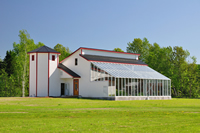
Quebec cheese maker powered by methane
July 31, 2013
By
Scott Jamieson
 July 31, 2013, Charlevoix, QC - A cheese maker northeast of Quebec City
is seeing a fast ROI on an anaerobic digester system it is using to
capture methane and heat its process.
July 31, 2013, Charlevoix, QC - A cheese maker northeast of Quebec City
is seeing a fast ROI on an anaerobic digester system it is using to
capture methane and heat its process.
“We have a very long-term view of our business, and that applies to
our investments as well,” says Bruno Labbé, co-owner and project manager
at Laiterie Charlevoix. This philosophy of longevity led to a project
that now enables the enterprise to use lactoserum, a cheese-making
by-product, as a renewable energy source to treat its wastewater and to
generate heat more efficiently. The project also won the company the
Énergia 2012 prize in the Industrial or Manufacturing Process
($5 million or less annually) awarded by the Association québécoise pour
la maîtrise de l’énergie (AQME).
Laiterie Charlevoix is a family-owned cheese factory located in Baie
Saint-Paul, Quebec. The company employs around 20 people and transforms
approximately 2 million litres of milk annually into 200 000 kilograms
of various cheese products.
Labbé explains that the company has been increasing its production
for many years now. Expansion, however, meant a significant increase in
fuel consumption for heating process water as well as 15 000 to 20 000
litres of lactoserum-laden wastewater to dispose of in a septic field
designed for 8 500 litres. Therefore, in designing its $3 million
facility expansion, the company incorporated lactoserum methanization
treatment followed by phytoremediation of remaining wastewater.
The methanization system, designed by Valbio Canada and Atis
Technologies and installed in 2011, consists of conditioning lactoserum
and “white water” in a 50‑cubic‑metre (m3) holding tank. The
fluid is then released into a 70 000‑litre methanizer in which anaerobic
bacteria decompose the organic matter reducing it by around 90 percent
and transforming it into methane, carbon dioxide and compost. The biogas
produced is continuously combusted in a biogas furnace. The heat is
then transferred to water, circulating in two 25 000‑litre reservoirs.
One reservoir is kept at 90 °C and the other at 75 °C. Both store the
water that now replaces the steam-generated hot water and steam used
directly as thermal fluid. Automatic controls, managed by a plant-wide
energy management system, allow for the production of hot water
according to the needs of the processes and the buildings. Remaining
contaminated water as well as other wastewater is treated in the same
building by using plants as biofilters, releasing clean water into the
nearby salmon-bearing stream.
The $903,000 methanization project had a 1.3 year return on
investment (ROI) after a $750,000 incentive from various Québec
government agencies. In addition to the savings in bunker oil, the new
heat storage system and the use of hot water instead of steam resulted
in additional savings of 25 to 30 percent annually. The company has now
also diverted 170 tonnes of CO2 annually and 11 tonnes associated with
the transport of lactoserum for disposal.
Labbé says that the Énergia prize “is a great recognition of the
company’s efforts.” The new project has also added another dimension to
the company’s facility tours that invites visitors to learn about the
cheese-making process. They can now also observe how environmentally and
energy-efficient the process can be.
This report was originally published as part of Natural Resources
Canada's CIPEC program newsletter, but has not been produced in affiliation
with, or with the endorsement of, Natural Resources Canada.
Print this page